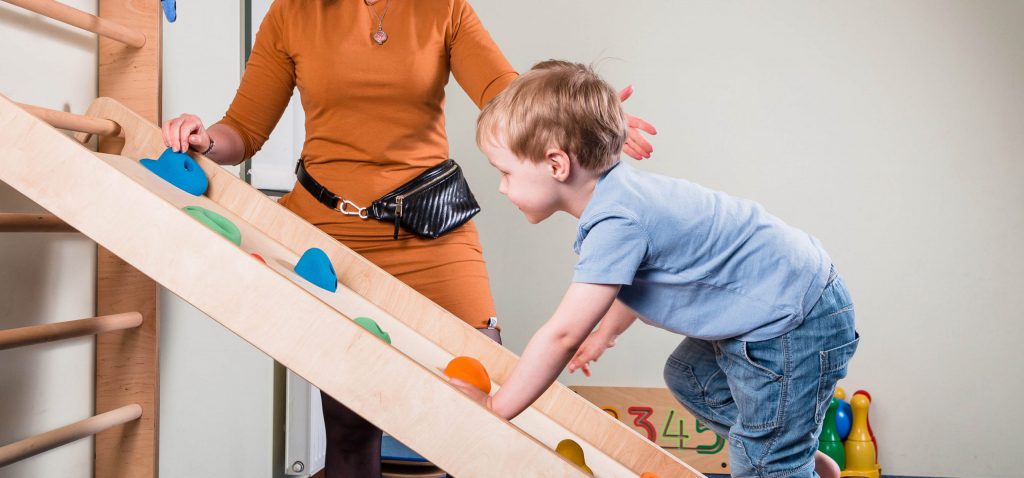
ABOUT PHYSICAL THERAPY
The main goals of physical therapy related-services at Yeled v’Yalda are to address the impairments in strength, balance, coordination, and mobility which affect the student’s functional task performance. Physical therapy goals relate to a range of functional outcomes, such as performing tasks in the classroom, participating in activities in the gym, or successfully engaging in any school-related task or play.
Our physical therapists use interviews, observation, evaluations, and may consult the gym curriculum to help establish benchmarks when assessing a child’s motor abilities. Physical therapy services help students in many important basic activities such as using handrails to access stairs within the school building, carrying school-related items such as artwork, lunch bags, or books and folders without losing balance, and overcoming other difficulties that cause students to be consistently slower than their peers.
The goal of Yeled v’Yalda’s physical therapy services is to help children overcome their functional limitations in order to foster independence, and limit their need for external assistance. Yeled v’Yalda’s physical therapists identify issues such as inadequate strength, poor proprioception, and lack of sufficient balance, which cause functional impairments in student ability.
Yeled v’Yalda’s physical therapists set functional goals for easy progress monitoring, identify functional limitations, and employ the most proficient and current methods to create child-friendly approaches to overcome developmental and medical hurdles. Each goal is carefully crafted as a well-defined task which is objectively measureable within the academic setting.
FAQs
As specialists in movement, Yeled v’Yalda’s physical therapists aim to assist and develop students’ physical participation in a variety of settings throughout the school day. The primary role of the school-based physical therapist is to help students maximally benefit from their educational program within the educational environment.
Physical therapy is provided at schools only for issues related to educational needs. Intervention and goals in the school setting address the child’s functional needs in accessing and participating in all areas of the school curriculum. Physical therapy interventions are designed to enable the student to navigate their school environment and participate in classroom activities. School-based therapy is not intended to meet all of the therapeutic needs of a student; rather, it is intended to ensure that a child can have physical access to his or her education.
The role of the physical therapist as a related-service provider in the school setting is not to meet the total medical needs of the student; students may have a medical diagnosis or motor impairment that does not interfere with their educational performance. Each area of need is closely scrutinized to determine its impact upon the student’s educational environment. The therapist will identify the performance problems in terms of functional criteria within the educational setting, relating to the student’s educational goals and needs. Yeled v’Yalda’s school-based physical therapy services address quality of movement as well as function. The primary objective is to maximize the child’s skill level and quality, in contrast with medically-based service models which are typically focused on physical impairments and on clinical deficits.
While the therapist is the child’s primary service provider, at Yeled v’Yalda we strongly believe in the importance of involving parents and teachers. Physical therapy can be held in a variety of environments, at times in a quiet setting due to the need to limit distractions and/or the use of specialized equipment, and at times within the student’s natural environment.
Students may have difficulties with:
- Physically negotiating the school setting;
- Walking, stair climbing, opening and closing doors, going up and down ramps, using wheelchair skills;
- Sensory processing, such as a dislike of touching a variety of textures, craving movement or being fearful of movement, or poor body awareness;
- Gross motor skills such as jumping, skipping, or hopping;
- Postural issues, including not sitting properly or slouching/slumping on their desk;
- Self-care skills, such as transferring on or off the toilet, dressing, and putting on or taking off their backpack;
- Balance skills including frequent falling or stumbling when walking;
- Coordination skills, such as difficulties throwing, catching, or kicking;
- Transition skills like getting on or off the school bus, walking in the classroom line, and transferring from sitting to standing.
Physical therapy sessions can include:
- Strengthening exercises;
- Stretching exercises;
- Instruction and practice of functional skills such as stair climbing, carrying books or backpacks, opening and closing doors, and walking activities in the classroom, hallway, cafeteria, gym class, etc.;
- Assessment and modification of adaptive equipment such as classroom desks and chairs, bathroom modifications, and positioning equipment;
- Activities to improve the large motor skills necessary for physical education and recess;
- Coordination activities to improve sensory processing such as obstacle courses, swinging, and jumping;
- Instruction and practice of wheelchair use;
- Activities to improve balance;
- Instruction to other school staff working with the student.
- Communicate often with the therapist: ask any questions you may have regarding the student’s treatment and progress;
- Ask the physical therapist for activities that can be carried out at home or in the classroom that will help support the child;
- Report your concerns regarding the child’s functional skills at home and in the classroom to the physical therapist.
